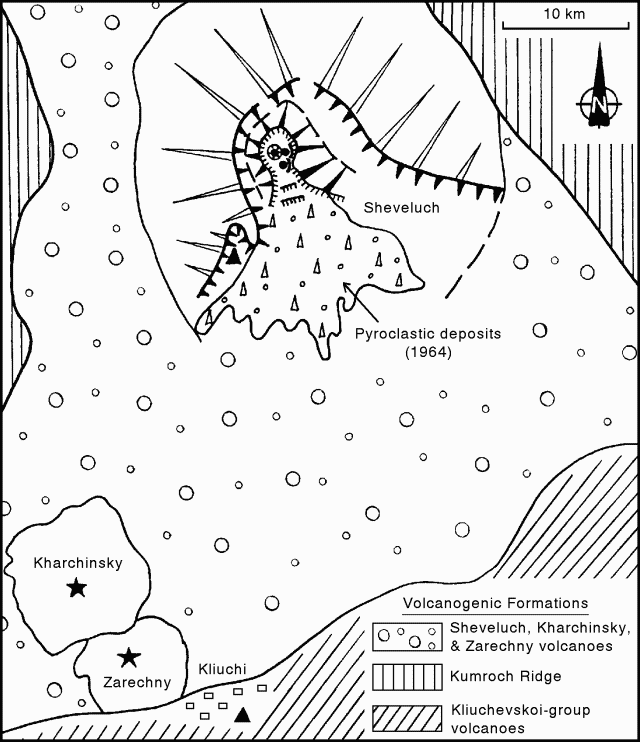Report on Sheveluch (Russia) — May 1993
Bulletin of the Global Volcanism Network, vol. 18, no. 5 (May 1993)
Managing Editor: Edward Venzke.
Sheveluch (Russia) Persistent gas-and-steam column; growth of extrusive dome
Please cite this report as:
Global Volcanism Program, 1993. Report on Sheveluch (Russia) (Venzke, E., ed.). Bulletin of the Global Volcanism Network, 18:5. Smithsonian Institution. https://doi.org/10.5479/si.GVP.BGVN199305-300270
Sheveluch
Russia
56.653°N, 161.36°E; summit elev. 3283 m
All times are local (unless otherwise noted)
A gas-and-steam column 1-5 km high has been observed every day that the volcano has been visible since the 22 April eruption. A small amount of ash was occasionally present in the plume, which varied in direction and distance with local wind conditions. The plume typically extended up to 40 km or more downwind. The extrusive dome inside the crater (figure 3) has continued to grow throughout May and early June.
During the week of 30 April to 6 May the gas-and-steam column was 3-5 km high with a plume that extended >30 km to the N. Shimmering lights were observed the night of 5 May on the surface of the extrusive dome inside the crater. At 2030 on 10 May a pyroclastic flow from the extrusive dome was seen inside the active crater. Numerous debris avalanches also formed that day on the SW slope of the growing dome. Several gas-and-steam bursts took place at 1200 on 7 May, sending material to a height of 2.5 km before drifting SSW. A gas-and-steam plume rose 2-2.5 km above the crater rim on 17 May, with the plume extending S for about 40 km. Poor weather conditions 11-21 May prevented frequent observations.
The steam-and-ash column from the crater rose to a height of 2-4 km from 21-27 May, and the plume extended up to 40 km N. By 27 May, the extrusive dome in the crater was ~800 m wide and 400 m high; it was 200 m high before the start of the eruption. From 27 May to 2 June, the height of the gas-and-steam column was ~2.5 km above the rim. A large number of avalanches off the extrusive dome indicated continued growth. Shimmering lights were observed on the dome at night. About 3-5 small explosions/day were occurring on the dome in early June, and the plume, carrying a small amount of ash, rose 1-3 km and extended up to 40 km S.
The level of seismicity increased 11 May and remained high through the 29th, when 8 tectonic earthquakes occurred beneath the volcano from 1600-2400. Volcanic tremor disappeared after the earthquakes, and had not returned by 2 June. Seismicity was continuing to decrease on 10 June, but was still above background levels.
Geological Summary. The high, isolated massif of Sheveluch volcano (also spelled Shiveluch) rises above the lowlands NNE of the Kliuchevskaya volcano group. The 1,300 km3 andesitic volcano is one of Kamchatka's largest and most active volcanic structures, with at least 60 large eruptions during the Holocene. The summit of roughly 65,000-year-old Stary Shiveluch is truncated by a broad 9-km-wide late-Pleistocene caldera breached to the south. Many lava domes occur on its outer flanks. The Molodoy Shiveluch lava dome complex was constructed during the Holocene within the large open caldera; Holocene lava dome extrusion also took place on the flanks of Stary Shiveluch. Widespread tephra layers from these eruptions have provided valuable time markers for dating volcanic events in Kamchatka. Frequent collapses of dome complexes, most recently in 1964, have produced debris avalanches whose deposits cover much of the floor of the breached caldera.
Information Contacts: V. Kirianov, IVGG.


